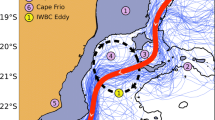Abstract
Using a 1.5-layer reduced-gravity nonlinear shallow-water equation model, we studied the effect of the meridional wind on the western boundary currents (WBC) at critical states with hysteresis courses. The results of the simulation indicate that the WBC is prone to penetrating into the gap under northerly winds, and its path is more difficult to alter due to the larger interval between the two critical transition curves (C 1 P and C 1 L). For southerly winds, the WBC is prone to leaping across the gap, and its path is easier to alter due to the smaller interval between the two critical transition curves. The simulation results also indicate that the meridional winds over the southern region of the gap are the dominant factor determining the formation of the WBC. The dynamic mechanism influencing the transport of WBC near the gap is both Ekman transport and the blocking of Ekman transport. Ekman transport induced by northerly winds may reduce the transport of the WBC, causing the β-effect to dominate the meridional advection (promoting the penetration). Southerly winds, however, may enhance the transport of the WBC, causing the meridional advection to dominate the β-effect (promoting the leaping state). These results explain some structural features of the Kuroshio at the Luzon Strait.
Similar content being viewed by others
References
Centurioni L R, Niiler P P, Lee D K. 2004. Observations of inflow of Philippine Sea surface water into the South China Sea through the Luzon Strait. J. Oceanogr., 34: 113–121.
Farris A, Wimbush M. 1996. Wind-induced Kuroshio intrusion into the South China Sea. J. Oceanogra., 52: 771–784.
Gan J P, Li H, Curchitser E N et al. 2006. Modeling South China Sea circulation: Response to seasonal forcing regimes. J. Geophys. Res., 111: C06034, doi:10.1029/2005JC003298.
Metzger E J, Hurlburt H E. 1996. Coupled dynamics of South China Sea, the Sulu Sea, and the Pacific Ocean. J. Geophys. Res., 111: 12 331–12 352.
Metzger E J. 2003. Upper ocean sensitivity to wind forcing in the South China Sea. J. Oceanogr. 59:6 783–6 798.
Nitani H. 1972. Beginning of the Kuroshio. Stommel H, Yoshida K. Kuroshio, Physical Aspect of the Japan Current, University of Washington, 129–163.
Sheremet V. 2001. Hysteresis of a western boundary current leaping across a gap. J. Phys. Oceanogr., 31: 1 247–1 259.
Su J, Guan B, Jiang J. 1990. The Kuroshio. Part I. Physical features. Oceanogr. and Marine Biology Annual Review, 28: 11–71.
Wang J, Chern C S. 1987a. The warm-core eddy in the northern South China Sea, I. Preliminary observations on the warm-core eddy. Acta Oceanographica Taiwanica, 18: 92–103. (in Chinese)
Wang J, Chern C S. 1987b. The warm-core eddy in the northern South China Sea, II. A simple mechanism for the establishment and development of the warm-core eddy. Acta Oceanographica Taiwanica, 18: 104–113. (in Chinese)
Yuan D L, Li R X. 2008. Dynamics of eddy-induced Kuroshio variability in Luzon Strait. J. Trop. Oceanogra., 27(4): 1–9. (in Chinese)
Yuan D L, Han W Q, Hu D X. 2006. Surface Kuroshio path in the Luzon Strait area derived from satellite remote sensing data. J. Geophys. Res., 111: C11007, doi:10.1029/2005JC003412
Author information
Authors and Affiliations
Corresponding author
Additional information
Supported by the Knowledge Innovation Program of Chinese Academy of Sciences (Nos. KZCX1-YW-12, KZCX2-YW-201), the National Natural Science Foundation of China (No. 90411013), the National Basic Research Program of China (973 Program, No. 2006CB403600), NSFC’s Outstanding Youth Grant (No. 40888001), the 100-Talent Program of the CAS, and the Outstanding Youth Grant of Shandong Province.
Rights and permissions
About this article
Cite this article
Wang, Z., Yuan, D. & Hou, Y. Effect of meridional wind on gap-leaping western boundary current. Chin. J. Ocean. Limnol. 28, 354–358 (2010). https://doi.org/10.1007/s00343-010-9281-1
Received:
Accepted:
Published:
Issue Date:
DOI: https://doi.org/10.1007/s00343-010-9281-1




